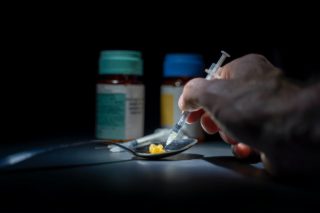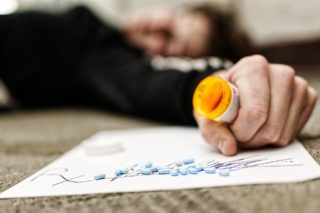Hardly a week goes by that you do not hear about a celebrity or someone in your community who has passed away from an accidental overdose involving fentanyl. While fentanyl is a synthetic opioid prescribed as a painkiller, many people with opiate addiction take a dangerous combination of prescription and illegal drugs. Even the smallest trace of a powerful drug like fentanyl can be lethal. Learn everything you need to know about this potentially deadly painkiller, as we answer the commonly asked question, “What is a lethal dose of fentanyl?”
What Is a Lethal Dosage of Fentanyl?


Table of Contents
What Is Fentanyl?
Fentanyl is a synthetic opioid1https://pubchem.ncbi.nlm.nih.gov/compound/Fentanyl developed in the 1960s and used as a painkiller to treat moderate to severe pain. It is legally manufactured and distributed in the United States, where it is often prescribed to patients who have had surgery or those suffering from chronic pain who have a tolerance to other opioids (i.e., need high or more frequent amounts to feel the effect). Fentanyl was initially developed to treat cancer patients and applied to the skin as a patch, called the fentanyl extended-release transdermal system. Now, in addition to the transdermal patch, fentanyl is also prescribed as a lozenge, pill, and liquid. According to the United States Drug Enforcement Administration2https://www.dea.gov/sites/default/files/2020-06/Fentanyl-2020_0.pdf (DEA), this narcotic is a controlled substance that is similar to other opioids except it is 50 times more powerful than heroin and 80-100 times more powerful than morphine. Because of its potency, it is a prescription drug that is commonly diverted (stolen and sold illegally) for misuse and abuse.
Brand Names for Fentanyl
- Abstral (sublingual tablets)
- Actiq (“lollipops”)
- Duragesic (transdermal patches)
- Fentora (effervescent buccal tablets)
- Lazanda (nasal spray)
- Onsolis (buccal soluble film)
- Sublimaze (injection)
- Subsys (sublingual spray)
Effects of Fentanyl?
Fentanyl, morphine, heroin, and many other opiates work in similar ways. These types of drugs bind to receptors in the brain that control pain and emotions. That is why opioids make one feel more relaxed and joyful. Unlike other drugs, fentanyl is unique because it binds and acts quickly. It also requires a much smaller dose than heroin or morphine. For this reason, fentanyl is a far more dangerous substance, especially when one develops a tolerance and dependency on it.
After taking opioids many times, the brain adapts to the drug, diminishing its sensitivity and making it hard to feel pleasure from anything besides the drug. When people become addicted, drug-seeking and drug use take over their lives. They may feel any or all of the following effects:
- Extreme high
- Relaxation
- Slow breathing
- Low blood pressure
- Dizziness
- Sedation
- Nausea
- Vomiting
- Urinary retention
- Constipation
- Constricted pupils
- Confusion
Substance use disorders are treatable with addiction recovery success rates showing much promise. However, it is important to have a support system to improve your chances of recovery. If you are ready to start your recovery journey, contact us to get started.
Fentanyl Misuse and Abuse
The prescription forms of fentanyl contain small, diluted amounts of the drug. When you hear about people overdosing, those cases typically involve an illegally made form of fentanyl. Fentanyl abuse first appeared in the 1970s and has been on the rise due to its euphoric (feelings of intense pleasure) effects. In 2019, more than 36,000 people in the U.S. died from opioids, resulting in a 15% increase in deaths3https://www.cdc.gov/drugoverdose/deaths/synthetic/index.html from 2018 to 2019.
The illegal form of fentanyl is created in discreet labs. You will typically find illicit fentanyl sold on the street as a powder, drops on blotter paper, liquid in eyedroppers, and nasal sprays. Also, the counterfeit pill form4https://www.dea.gov/onepill is frequently made to look like other prescription medications. It may be mixed with other common street drugs, including cocaine and heroin. The DEA seized more than 9.6 million fake pills laced with fentanyl5https://www.dea.gov/sites/default/files/2021-09/DEA_Fact_Sheet-Counterfeit_Pills.pdf, a 430% increase since 20196https://www.dea.gov/onepill.
Common Street Names for Fentanyl
- Apace
- Captain Cody
- China Girl
- China Town
- China White
- Dance Fever
- Goodfella
- Great Bear
- He-Man
- Hillbilly Heroin
- King Ivory
- Murder 8
- Oxycat
- Percs
- Poison
- Tango & Cash
Carfentanil is one of many fentanyl analogs, which are drugs manufactured to imitate the effects of other drugs. These drugs have a similar makeup as fentanyl but may not show up in drug tests. The potency of drug analogs varies from less than to greater than fentanyl. Carfentanil, in particular, is believed to be 10,000 times stronger than fentanyl. In fact, there was a 540% increase in deaths by fentanyl analogs between 2013 and 2016.
Drug dealers often sell fentanyl mixed with methamphetamine, heroin, cocaine, and other drugs. Because fentanyl is so potent in small amounts, it is cheaper to make and enhances the effect of other drugs. Unfortunately, many people who buy drugs on the street may unknowingly get a mixture containing lethal doses of fentanyl.
The abuse of painkillers is very common, but there are ways to overcome addiction. At Windward Way Recovery, we understand what families go through when dealing with the recovery process; that is why we offer programs to support the family along with the individual seeking treatment for addiction.
Signs of Fentanyl Overdose
People who use fentanyl can experience an overdose, which occurs when a drug causes severe and life-threatening symptoms. Typically, a fentanyl overdose will cause a person’s breathing to be impaired. When the brain does not get enough oxygen, one can go into a coma and suffer from brain damage. The effects of fentanyl on the brain also slow down the function of other major organs, including the heart, kidneys, and lungs, as well as a person’s motor function.
Potent doses of fentanyl cause a user to experience several dangerous side effects beyond the initial euphoric feelings. When three symptoms are present at the same time, such as coma, small pupils, and difficulty breathing, overdose is very likely. Immediate medical care must be administered to keep that person from suffering from lasting complications and even death. Other dangerous side effects that can lead to death include:
- Stupor
- Cold, clammy skin
- Cyanosis (blue skin)
- Seizures
- Respiratory failure
How to Treat a Fentanyl Overdose
If caught early enough and before it reaches the final life-threatening stage, fentanyl overdose can be treated. Naloxone is a medication that is effective against fentanyl and other opioids if given immediately. It binds to the opioid receptors in the brain, so that the effects of fentanyl are blocked. The solution can be injected with a needle. The brand names Narcan and Kloxxado are also naloxone but used as a nose spray. Because fentanyl is one of the most potent opioids, naloxone may have to be given multiple times to fully treat the overdose.
If you suspect someone is overdosing on fentanyl, you can take the following actions:
- Call 911 immediately.
- Roll the person on their side in case they vomit to prevent choking.
- Monitor the person’s breathing and avoid giving any fluid.
- If the person is not breathing, perform cardiopulmonary resuscitation (CPR).
- Administer naloxone if trained to do so.
In some states, naloxone is available from the pharmacy without needing a prescription. Having naloxone available can be handy in the event you or a family member abuse fentanyl and suffer from an overdose. However, when an overdose is suspected, it is always crucial to contact 911 for emergency medical attention right away, as time is of the essence. This is especially true because a single dose of naloxone might not be enough if someone is overdosing on fentanyl. Once medical professionals administer treatment, patients are usually monitored for a couple of hours to make sure their breathing remains normal.
What Is a Lethal Dose of Fentanyl?
Fentanyl is often abused by addicts who obtain it on the street or illegally. Based on lab results, 2 out of 5 seized counterfeit pills contain lethal doses7https://www.dea.gov/onepill, which the DEA defines as being 2 mg of fentanyl8https://www.dea.gov/sites/default/files/2021-09/DEA_Fact_Sheet-Counterfeit_Pills.pdf. However, the different forms of lab-created fentanyl and its analogs, along with it being often combined with other illicit drugs, make it very difficult to determine a specific amount that would lead to death. Fentanyl also affects individuals differently, so what might be fatal for one person might not be for another. Simply put, any use of fentanyl is potentially deadly.
When you seek help from Windward Way Recovery, we offer a customized plan developed to help you decide what makes sense for your needs and life. Learn about the different levels of care for substance abuse recovery and reach out to us if you have any questions.
Fentanyl Addiction and Withdrawal Symptoms
One can become addicted to fentanyl. Because fentanyl is often mixed with other drugs, it poses greater risks that can be harmful to the body. In addition, it can cause one to become more dependent on the drug. Over time, one will find that their brain and body will want and require more fentanyl. When the body is without certain levels of the drug, it can go into withdrawal. Withdrawal symptoms often feel like the flu, and may include:
- Irritability or sadness
- Anxiety
- Insomnia
- Fever and sweating
- Chills and goosebumps
- Runny nose
- Muscle aches
- Nausea and vomiting
- Diarrhea and cramping
A user typically experiences fentanyl withdrawal symptoms within about 12 hours after using it. Within several days, users will find that their symptoms reach a peak and start to diminish over the course of a week. It is possible to have minor effects for a few continued weeks. The extent of withdrawal symptoms will depend on how much fentanyl was taken, how frequently it was used, and what other drugs were taken with it. The following factors also influence withdrawal symptoms:
- Taking more doses than prescribed
- Frequently using fentanyl more than intended
- Mixing fentanyl with multiple drugs
- Using another patient’s prescription
- Abusing illegally produced fentanyl
Overcoming Addiction to Fentanyl and Related Drugs
Not only can fentanyl and other opiates be addictive, but they also can be lethal. This is especially true when mixing heroin, cocaine, meth, and/or fentanyl together. It is also very dangerous to buy street drugs because you never know if fentanyl might be mixed into it. Even a small dose of fentanyl can cause serious side effects, including coma and death. One pill can kill9http://uthscsa.edu/ARTT/AddictionJC/2020-02-11-Sutter.pdf.
If you or a loved one is struggling with opioid or fentanyl addition, there is help available. You can find out more about our drug and alcohol addiction treatment process, which is always customized to meet your individual needs. If you are suffering from drug addiction, the professional team at Windward Way Recovery can help.
Windward Way Recovery offers a wide range of treatment programs and resources to help those suffering from opiate addiction and other substance abuse disorders. We serve individuals in our tranquil California facility where they can get started on the road to recovery.
To learn about how we can help, you can reach us online or by phone at (855) 491-7694.
- 1https://pubchem.ncbi.nlm.nih.gov/compound/Fentanyl
- 2https://www.dea.gov/sites/default/files/2020-06/Fentanyl-2020_0.pdf
- 3https://www.cdc.gov/drugoverdose/deaths/synthetic/index.html
- 4https://www.dea.gov/onepill
- 5https://www.dea.gov/sites/default/files/2021-09/DEA_Fact_Sheet-Counterfeit_Pills.pdf
- 6https://www.dea.gov/onepill
- 7https://www.dea.gov/onepill
- 8https://www.dea.gov/sites/default/files/2021-09/DEA_Fact_Sheet-Counterfeit_Pills.pdf
- 9http://uthscsa.edu/ARTT/AddictionJC/2020-02-11-Sutter.pdf




